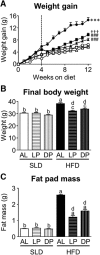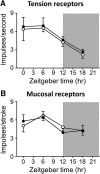Time-Restricted Feeding Prevents Ablation of Diurnal Rhythms in Gastric Vagal Afferent Mechanosensitivity Observed in High-Fat Diet-Induced Obese Mice
- PMID: 29760179
- PMCID: PMC6705946
- DOI: 10.1523/JNEUROSCI.0052-18.2018
Time-Restricted Feeding Prevents Ablation of Diurnal Rhythms in Gastric Vagal Afferent Mechanosensitivity Observed in High-Fat Diet-Induced Obese Mice
Abstract
Mechanosensitive gastric vagal afferents (GVAs) are involved in the regulation of food intake. GVAs exhibit diurnal rhythmicity in their response to food-related stimuli, allowing time of day-specific satiety signaling. This diurnal rhythmicity is ablated in high-fat-diet (HFD)-induced obesity. Time-restricted feeding (TRF) has a strong influence on peripheral clocks. This study aimed to determine whether diurnal patterns in GVA mechanosensitivity are entrained by TRF. Eight-week-old male C57BL/6 mice (N = 256) were fed a standard laboratory diet (SLD) or HFD for 12 weeks. After 4 weeks of diet acclimatization, the mice were fed either ad libitum or only during the light phase [Zeitgeber time (ZT) 0-12] or dark phase (ZT12-24) for 8 weeks. A subgroup of mice from all conditions (n = 8/condition) were placed in metabolic cages. After 12 weeks, ex vivo GVA recordings were taken at 3 h intervals starting at ZT0. HFD mice gained more weight than SLD mice. TRF did not affect weight gain in the SLD mice, but decreased weight gain in the HFD mice regardless of the TRF period. In SLD mice, diurnal rhythms in food intake were inversely associated with diurnal rhythmicity of GVA mechanosensitivity. These diurnal rhythms were entrained by the timing of food intake. In HFD mice, diurnal rhythms in food intake and diurnal rhythmicity of GVA mechanosensitivity were dampened. Loss of diurnal rhythmicity in HFD mice was abrogated by TRF. In conclusion, diurnal rhythmicity in GVA responses to food-related stimuli can be entrained by food intake. TRF prevents the loss of diurnal rhythmicity that occurs in HFD-induced obesity.SIGNIFICANCE STATEMENT Diurnal control of food intake is vital for maintaining metabolic health. Diet-induced obesity is associated with strong diurnal changes in food intake. Vagal afferents are involved in regulation of feeding behavior, particularly meal size, and exhibit diurnal fluctuations in mechanosensitivity. These diurnal fluctuations in vagal afferent mechanosensitivity are lost in diet-induced obesity. This study provides evidence that time-restricted feeding entrains diurnal rhythmicity in vagal afferent mechanosensitivity in lean and high-fat-diet (HFD)-induced obese mice and, more importantly, prevents the loss of rhythmicity in HFD-induced obesity. These data have important implications for the development of strategies to treat obesity.
Keywords: circadian rhythmicity; obesity; stomach; time-restricted feeding; vagal afferents.
Copyright © 2018 the authors 0270-6474/18/385088-08$15.00/0.
Figures






Similar articles
-
Gastrointestinal Vagal Afferents and Food Intake: Relevance of Circadian Rhythms.Nutrients. 2021 Mar 5;13(3):844. doi: 10.3390/nu13030844. Nutrients. 2021. PMID: 33807524 Free PMC article. Review.
-
High-Fat Diet-Induced Obesity Ablates Gastric Vagal Afferent Circadian Rhythms.J Neurosci. 2016 Mar 16;36(11):3199-207. doi: 10.1523/JNEUROSCI.2710-15.2016. J Neurosci. 2016. PMID: 26985030 Free PMC article.
-
Disruption of the light cycle ablates diurnal rhythms in gastric vagal afferent mechanosensitivity.Neurogastroenterol Motil. 2019 Dec;31(12):e13711. doi: 10.1111/nmo.13711. Epub 2019 Sep 11. Neurogastroenterol Motil. 2019. PMID: 31509314
-
Pregnancy and a high-fat, high-sugar diet each attenuate mechanosensitivity of murine gastric vagal afferents, with no additive effects.J Physiol. 2025 Mar;603(6):1461-1481. doi: 10.1113/JP286115. Epub 2025 Mar 2. J Physiol. 2025. PMID: 40023799 Free PMC article.
-
Response of peripheral rhythms to the timing of food intake.Methods Enzymol. 2015;552:145-61. doi: 10.1016/bs.mie.2014.10.027. Epub 2014 Dec 27. Methods Enzymol. 2015. PMID: 25707276 Review.
Cited by
-
Time-Restricted Feeding Improves Body Weight Gain, Lipid Profiles, and Atherogenic Indices in Cafeteria-Diet-Fed Rats: Role of Browning of Inguinal White Adipose Tissue.Nutrients. 2020 Jul 23;12(8):2185. doi: 10.3390/nu12082185. Nutrients. 2020. PMID: 32717874 Free PMC article.
-
Gastrointestinal Vagal Afferents and Food Intake: Relevance of Circadian Rhythms.Nutrients. 2021 Mar 5;13(3):844. doi: 10.3390/nu13030844. Nutrients. 2021. PMID: 33807524 Free PMC article. Review.
-
Time-Restricted Eating: Benefits, Mechanisms, and Challenges in Translation.iScience. 2020 Jun 26;23(6):101161. doi: 10.1016/j.isci.2020.101161. Epub 2020 May 15. iScience. 2020. PMID: 32480126 Free PMC article. Review.
-
Time-restricted Eating for the Prevention and Management of Metabolic Diseases.Endocr Rev. 2022 Mar 9;43(2):405-436. doi: 10.1210/endrev/bnab027. Endocr Rev. 2022. PMID: 34550357 Free PMC article.
-
Finding balance: understanding the energetics of time-restricted feeding in mice.Obesity (Silver Spring). 2023 Feb;31 Suppl 1(Suppl 1):22-39. doi: 10.1002/oby.23607. Epub 2022 Dec 13. Obesity (Silver Spring). 2023. PMID: 36513496 Free PMC article. Review.
References
Publication types
MeSH terms
LinkOut - more resources
Full Text Sources
Other Literature Sources
Medical
